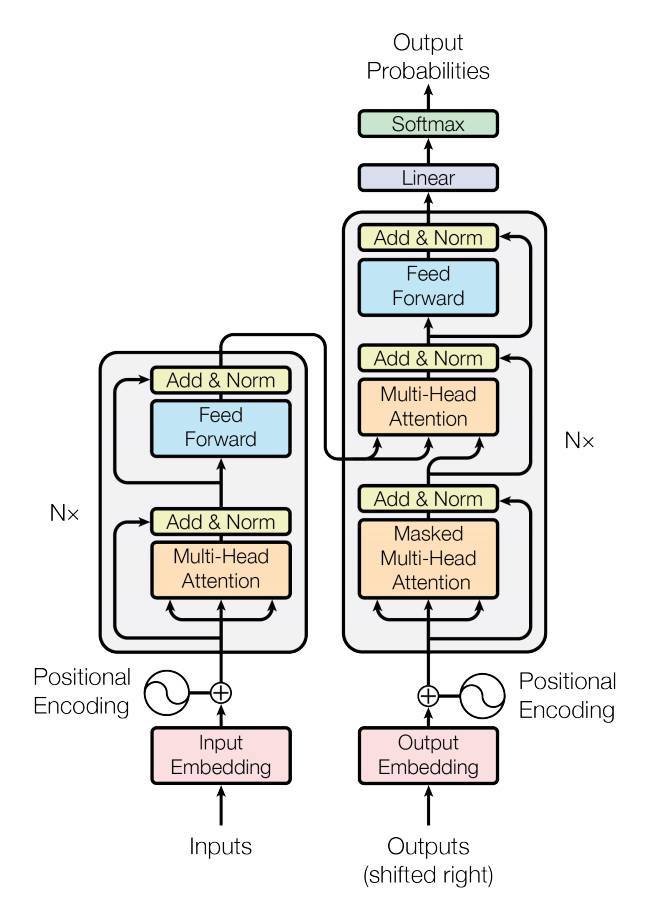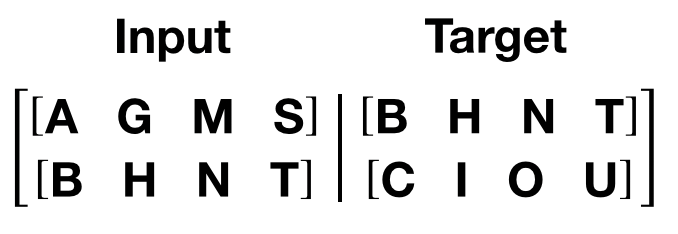


참고
Go to the end to download the full example code.
nn.Transformer 와 torchtext로 시퀀스-투-시퀀스(Sequence-to-Sequence) 모델링하기#
이 튜토리얼에서는 nn.Transformer 모듈을 이용하는 시퀀스-투-시퀀스(Sequence-to-Sequence) 모델을 학습하는 방법을 배워보겠습니다.
PyTorch 1.2 버젼에는 Attention is All You Need 논문에
기반한 표준 트랜스포머(transformer) 모듈을 포함하고 있습니다.
트랜스포머 모델은 다양한 시퀀스-투-시퀀스 문제들에서 더 병렬화(parallelizable)가 가능하면서도
순환 신경망(RNN; Recurrent Neural Network)과 비교하여 더 나은 성능을 보임이 입증되었습니다.
nn.Transformer 모듈은 입력(input) 과 출력(output) 사이의 전역적인 의존성(global dependencies)
을 나타내기 위하여 (nn.MultiheadAttention 으로
구현된) 어텐션(attention) 메커니즘에 전적으로 의존합니다.
현재 nn.Transformer 모듈은 모듈화가 잘 되어 있어
단일 컴포넌트 (예. nn.TransformerEncoder )
로 쉽게 적용 및 구성할 수 있습니다.

모델 정의하기#
이 튜토리얼에서, 우리는 nn.TransformerEncoder 모델을 언어 모델링(language modeling) 과제에 대해서 학습시킬 것입니다.
언어 모델링 과제는 주어진 단어 (또는 단어의 시퀀스) 가 다음에 이어지는 단어 시퀀스를 따를 가능성(likelihood)에 대한 확률을 할당하는 것입니다.
먼저, 토큰(token) 들의 시퀀스가 임베딩(embedding) 레이어로 전달되며, 이어서 포지셔널 인코딩(positional encoding) 레이어가 각 단어의 순서를 설명합니다.
(더 자세한 설명은 다음 단락을 참고해주세요.)
nn.TransformerEncoder 는 여러 개의
nn.TransformerEncoderLayer
레이어로 구성되어 있습니다.
nn.TransformerEncoder 내부의 셀프-어텐션(self-attention) 레이어들은 시퀀스 안에서의 이전 포지션에만 집중하도록 허용되기 때문에,
입력(input) 순서와 함께, 정사각 형태의 어텐션 마스크(attention mask) 가 필요합니다.
언어 모델링 과제를 위해서, 미래의 포지션에 있는 모든 토큰들은 마스킹 되어야(가려져야) 합니다.
실제 단어를 얻기 위해서, nn.TransformerEncoder 의 출력은 로그-소프트맥스(log-Softmax) 로 이어지는 최종 선형(Linear) 레이어로 전달 됩니다.
import math
import os
from tempfile import TemporaryDirectory
from typing import Tuple
import torch
from torch import nn, Tensor
import torch.nn.functional as F
from torch.nn import TransformerEncoder, TransformerEncoderLayer
from torch.utils.data import dataset
class TransformerModel(nn.Module):
def __init__(self, ntoken: int, d_model: int, nhead: int, d_hid: int,
nlayers: int, dropout: float = 0.5):
super().__init__()
self.model_type = 'Transformer'
self.pos_encoder = PositionalEncoding(d_model, dropout)
encoder_layers = TransformerEncoderLayer(d_model, nhead, d_hid, dropout)
self.transformer_encoder = TransformerEncoder(encoder_layers, nlayers)
self.encoder = nn.Embedding(ntoken, d_model)
self.d_model = d_model
self.decoder = nn.Linear(d_model, ntoken)
self.init_weights()
def init_weights(self) -> None:
initrange = 0.1
self.encoder.weight.data.uniform_(-initrange, initrange)
self.decoder.bias.data.zero_()
self.decoder.weight.data.uniform_(-initrange, initrange)
def forward(self, src: Tensor, src_mask: Tensor) -> Tensor:
"""
Arguments:
src: Tensor, shape ``[seq_len, batch_size]``
src_mask: Tensor, shape ``[seq_len, seq_len]``
Returns:
output Tensor of shape ``[seq_len, batch_size, ntoken]``
"""
src = self.encoder(src) * math.sqrt(self.d_model)
src = self.pos_encoder(src)
output = self.transformer_encoder(src, src_mask)
output = self.decoder(output)
return output
def generate_square_subsequent_mask(sz: int) -> Tensor:
"""Generates an upper-triangular matrix of ``-inf``, with zeros on ``diag``."""
return torch.triu(torch.ones(sz, sz) * float('-inf'), diagonal=1)
PositionalEncoding 모듈은 시퀀스 안에서 토큰의 상대적인 또는 절대적인 포지션에 대한 어떤 정보를 주입합니다.
포지셔널 인코딩은 임베딩과 합칠 수 있도록 똑같은 차원을 가집니다.
여기에서, 우리는 다른 주파수(frequency) 의 sine 과 cosine 함수를 사용합니다.
class PositionalEncoding(nn.Module):
def __init__(self, d_model: int, dropout: float = 0.1, max_len: int = 5000):
super().__init__()
self.dropout = nn.Dropout(p=dropout)
position = torch.arange(max_len).unsqueeze(1)
div_term = torch.exp(torch.arange(0, d_model, 2) * (-math.log(10000.0) / d_model))
pe = torch.zeros(max_len, 1, d_model)
pe[:, 0, 0::2] = torch.sin(position * div_term)
pe[:, 0, 1::2] = torch.cos(position * div_term)
self.register_buffer('pe', pe)
def forward(self, x: Tensor) -> Tensor:
"""
Arguments:
x: Tensor, shape ``[seq_len, batch_size, embedding_dim]``
"""
x = x + self.pe[:x.size(0)]
return self.dropout(x)
데이터 로드하고 배치 만들기#
이 튜토리얼에서는 torchtext 를 사용하여 Wikitext-2 데이터셋을 생성합니다.
torchtext 데이터셋에 접근하기 전에, pytorch/data 을 참고하여 torchdata를 설치하시기 바랍니다.
%%
%%bash pip install torchdata
어휘(vocab) 객체는 훈련 데이터셋(train dataset) 에 의하여 만들어지고, 토큰(token)을 텐서(tensor)로 수치화하는데 사용됩니다. Wikitext-2에서 보기 드문 토큰(rare token)은 <unk> 로 표현됩니다.
주어진 1D 벡터의 시퀀스 데이터에서, batchify() 함수는 데이터를 batch_size 컬럼들로 정렬합니다.
만약 데이터가 batch_size 컬럼으로 나누어 떨어지지 않으면, 데이터를 잘라내서 맞춥니다.
예를 들어 (총 길이 26의) 알파벳을 데이터로 보고 batch_size=4 일 때, 알파벳은 길이가 6인 4개의 시퀀스로 나눠집니다:
배치 작업(batching)은 더 많은 병렬 처리를 가능하게 하지만, 모델이 독립적으로 각 컬럼들을 취급해야 함을 뜻합니다;
예를 들어, 위 예제에서 G 와 F 의 의존성(dependance)은 학습되지 않습니다.
from torchtext.datasets import WikiText2
from torchtext.data.utils import get_tokenizer
from torchtext.vocab import build_vocab_from_iterator
train_iter = WikiText2(split='train')
tokenizer = get_tokenizer('basic_english')
vocab = build_vocab_from_iterator(map(tokenizer, train_iter), specials=['<unk>'])
vocab.set_default_index(vocab['<unk>'])
def data_process(raw_text_iter: dataset.IterableDataset) -> Tensor:
"""Converts raw text into a flat Tensor."""
data = [torch.tensor(vocab(tokenizer(item)), dtype=torch.long) for item in raw_text_iter]
return torch.cat(tuple(filter(lambda t: t.numel() > 0, data)))
# ``train_iter`` was "consumed" by the process of building the vocab,
# so we have to create it again
train_iter, val_iter, test_iter = WikiText2()
train_data = data_process(train_iter)
val_data = data_process(val_iter)
test_data = data_process(test_iter)
device = torch.device('cuda' if torch.cuda.is_available() else 'cpu')
def batchify(data: Tensor, bsz: int) -> Tensor:
"""Divides the data into ``bsz`` separate sequences, removing extra elements
that wouldn't cleanly fit.
Arguments:
data: Tensor, shape ``[N]``
bsz: int, batch size
Returns:
Tensor of shape ``[N // bsz, bsz]``
"""
seq_len = data.size(0) // bsz
data = data[:seq_len * bsz]
data = data.view(bsz, seq_len).t().contiguous()
return data.to(device)
batch_size = 20
eval_batch_size = 10
train_data = batchify(train_data, batch_size) # shape [seq_len, batch_size]
val_data = batchify(val_data, eval_batch_size)
test_data = batchify(test_data, eval_batch_size)
Traceback (most recent call last):
File "/workspace/tutorials-kr/beginner_source/transformer_tutorial.py", line 163, in <module>
from torchtext.datasets import WikiText2
File "/opt/conda/lib/python3.11/site-packages/torchtext/__init__.py", line 18, in <module>
from torchtext import _extension # noqa: F401
^^^^^^^^^^^^^^^^^^^^^^^^^^^^^^^^
File "/opt/conda/lib/python3.11/site-packages/torchtext/_extension.py", line 64, in <module>
_init_extension()
File "/opt/conda/lib/python3.11/site-packages/torchtext/_extension.py", line 58, in _init_extension
_load_lib("libtorchtext")
File "/opt/conda/lib/python3.11/site-packages/torchtext/_extension.py", line 50, in _load_lib
torch.ops.load_library(path)
File "/opt/conda/lib/python3.11/site-packages/torch/_ops.py", line 1478, in load_library
ctypes.CDLL(path)
File "/opt/conda/lib/python3.11/ctypes/__init__.py", line 376, in __init__
self._handle = _dlopen(self._name, mode)
^^^^^^^^^^^^^^^^^^^^^^^^^
OSError: /opt/conda/lib/python3.11/site-packages/torchtext/lib/libtorchtext.so: undefined symbol: _ZN5torch6detail10class_baseC2ERKSsS3_SsRKSt9type_infoS6_
입력(input) 과 타겟(target) 시퀀스를 생성하기 위한 함수들#
get_batch() 함수는 트랜스포머 모델을 위한 입력-타겟 시퀀스 쌍(pair)을 생성합니다.
이 함수는 소스 데이터를 bptt 길이를 가진 덩어리로 세분화 합니다.
언어 모델링 과제를 위해서, 모델은 다음 단어인 Target 이 필요 합니다.
예를 들어, bptt 의 값이 2 라면, 우리는 i = 0 일 때 다음의 2 개의 변수(Variable) 를 얻을 수 있습니다:

변수 덩어리는 트랜스포머 모델의 S 차원과 일치하는 0 차원에 해당합니다.
배치 차원 N 은 1 차원에 해당합니다.
bptt = 35
def get_batch(source: Tensor, i: int) -> Tuple[Tensor, Tensor]:
"""
Arguments:
source: Tensor, shape ``[full_seq_len, batch_size]``
i: int
Returns:
tuple ``(data, target)``, where data has shape ``[seq_len, batch_size]`` and
target has shape ``[seq_len * batch_size]``
"""
seq_len = min(bptt, len(source) - 1 - i)
data = source[i:i+seq_len]
target = source[i+1:i+1+seq_len].reshape(-1)
return data, target
인스턴스(instance) 초기화하기#
모델의 하이퍼파라미터(hyperparameter)는 아래와 같이 정의됩니다.
어휘집( vocab )의 크기는 단어 오브젝트의 길이와 일치 합니다.
ntokens = len(vocab) # 단어 사전(어휘집)의 크기
emsize = 200 # 임베딩 차원
d_hid = 200 # ``nn.TransformerEncoder`` 에서 피드포워드 네트워크(feedforward network) 모델의 차원
nlayers = 2 # ``nn.TransformerEncoder`` 내부의 nn.TransformerEncoderLayer 개수
nhead = 2 # ``nn.MultiheadAttention`` 의 헤드 개수
dropout = 0.2 # 드랍아웃(dropout) 확률
model = TransformerModel(ntokens, emsize, nhead, d_hid, nlayers, dropout).to(device)
모델 실행하기#
CrossEntropyLoss 를 SGD (확률적 경사 하강법) 옵티마이저(optimizer)와 함께 사용하였습니다. 학습률(learning rate)는 5.0으로 초기화하였으며 StepLR 스케쥴을 따릅니다. 학습하는 동안, nn.utils.clip_grad_norm_ 을 사용하여 기울기(gradient)가 폭발(exploding)하지 않도록 합니다.
import copy
import time
criterion = nn.CrossEntropyLoss()
lr = 5.0 # 학습률(learning rate)
optimizer = torch.optim.SGD(model.parameters(), lr=lr)
scheduler = torch.optim.lr_scheduler.StepLR(optimizer, 1.0, gamma=0.95)
def train(model: nn.Module) -> None:
model.train() # 학습 모드 시작
total_loss = 0.
log_interval = 200
start_time = time.time()
src_mask = generate_square_subsequent_mask(bptt).to(device)
num_batches = len(train_data) // bptt
for batch, i in enumerate(range(0, train_data.size(0) - 1, bptt)):
data, targets = get_batch(train_data, i)
seq_len = data.size(0)
if seq_len != bptt: # 마지막 배치에만 적용
src_mask = src_mask[:seq_len, :seq_len]
output = model(data, src_mask)
loss = criterion(output.view(-1, ntokens), targets)
optimizer.zero_grad()
loss.backward()
torch.nn.utils.clip_grad_norm_(model.parameters(), 0.5)
optimizer.step()
total_loss += loss.item()
if batch % log_interval == 0 and batch > 0:
lr = scheduler.get_last_lr()[0]
ms_per_batch = (time.time() - start_time) * 1000 / log_interval
cur_loss = total_loss / log_interval
ppl = math.exp(cur_loss)
print(f'| epoch {epoch:3d} | {batch:5d}/{num_batches:5d} batches | '
f'lr {lr:02.2f} | ms/batch {ms_per_batch:5.2f} | '
f'loss {cur_loss:5.2f} | ppl {ppl:8.2f}')
total_loss = 0
start_time = time.time()
def evaluate(model: nn.Module, eval_data: Tensor) -> float:
model.eval() # 평가 모드 시작
total_loss = 0.
src_mask = generate_square_subsequent_mask(bptt).to(device)
with torch.no_grad():
for i in range(0, eval_data.size(0) - 1, bptt):
data, targets = get_batch(eval_data, i)
seq_len = data.size(0)
if seq_len != bptt:
src_mask = src_mask[:seq_len, :seq_len]
output = model(data, src_mask)
output_flat = output.view(-1, ntokens)
total_loss += seq_len * criterion(output_flat, targets).item()
return total_loss / (len(eval_data) - 1)
에포크 내에서 반복됩니다. 만약 검증 오차(validation loss) 가 우리가 지금까지 관찰한 것 중 최적이라면 모델을 저장합니다. 매 에포크 이후에 학습률을 조절합니다.
best_val_loss = float('inf')
epochs = 3
with TemporaryDirectory() as tempdir:
best_model_params_path = os.path.join(tempdir, "best_model_params.pt")
for epoch in range(1, epochs + 1):
epoch_start_time = time.time()
train(model)
val_loss = evaluate(model, val_data)
val_ppl = math.exp(val_loss)
elapsed = time.time() - epoch_start_time
print('-' * 89)
print(f'| end of epoch {epoch:3d} | time: {elapsed:5.2f}s | '
f'valid loss {val_loss:5.2f} | valid ppl {val_ppl:8.2f}')
print('-' * 89)
if val_loss < best_val_loss:
best_val_loss = val_loss
torch.save(model.state_dict(), best_model_params_path)
scheduler.step()
model.load_state_dict(torch.load(best_model_params_path)) # load best model states
평가 데이터셋(test dataset)으로 모델을 평가하기#
test_loss = evaluate(model, test_data)
test_ppl = math.exp(test_loss)
print('=' * 89)
print(f'| End of training | test loss {test_loss:5.2f} | '
f'test ppl {test_ppl:8.2f}')
print('=' * 89)
Total running time of the script: (0 minutes 0.007 seconds)
